This is Page 5b of a six-page article. Click on the black links below to visit other pages.
The Hot Chocolate Mix Manifesto, Continued
Check For Low Sodium
When I was an 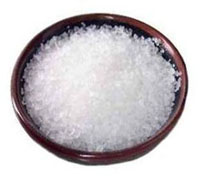 R&D intern at Guittard Chocolate, I learned that chocolate and salt have a special relationship. In the complete absence of salt, even a favorite chocolate dessert can sometimes taste flat and less chocolatey. The key lies in the amount of salt used: Only a minimal quantity is required to bring out that full chocolate flavor we all desire. When I make hot cocoa, hot chocolate, or anything chocolate from scratch, I always throw in just a tiny amount. For a cup of hot chocolate, that “tiny amount” will be literally a few grains. For larger desserts, such as a cake or pan of brownies, it might be as much as 1/8 to 1/4 of a teaspoon.
R&D intern at Guittard Chocolate, I learned that chocolate and salt have a special relationship. In the complete absence of salt, even a favorite chocolate dessert can sometimes taste flat and less chocolatey. The key lies in the amount of salt used: Only a minimal quantity is required to bring out that full chocolate flavor we all desire. When I make hot cocoa, hot chocolate, or anything chocolate from scratch, I always throw in just a tiny amount. For a cup of hot chocolate, that “tiny amount” will be literally a few grains. For larger desserts, such as a cake or pan of brownies, it might be as much as 1/8 to 1/4 of a teaspoon.
Having said that, some brands of hot cocoa or hot chocolate contain significant amounts of sodium. Values for sodium ranged from 0 mg up to a whopping 230 mg per serving, and that was just among manufacturers who listed sodium content (not all do). Surprisingly, it wasn’t just inexpensive store brands that had higher sodium contents; Garrison Ultimate Hot Chocolate weighed in with 160 mg of sodium per serving. While few of these chocolate beverages tasted salty, those with higher amounts of sodium could be an issue for children or adults who should be watching their sodium intake.
Look For Relatively Simple Instructions (And Hope They Work)
Drinking chocolate preparations are a convenience product, period. Many people don’t want to have to do anything more complex than heat water to prepare a hot 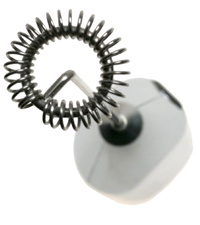 chocolate drink. Others among us don’t mind going to a little more trouble to achieve a really delicious product, but some manufacturer’s preparation instructions bordered on the ridiculous.
chocolate drink. Others among us don’t mind going to a little more trouble to achieve a really delicious product, but some manufacturer’s preparation instructions bordered on the ridiculous.
The first recipe on the box of Vosges Haut Chocolat Couture Cocoa calls for milk, heavy cream, and water. After bringing the liquid to a boil in a saucepan, you whisk in the mix until it’s dissolved. Then, the cocoa steeps for 5 to 7 minutes. Following the steeping, you’re supposed to place the cocoa in a blender for about a minute, until it’s doubled in volume, with abundant bubbles. You can also use an immersion blender or a molinillo, if you know anyone who even possesses the latter (it’s the grooved wooden stirring stick used by the ancient Olmecs, Mayas and Aztecs to froth their chocolate beverage—you roll it rapidly between your hands). You’re advised, too, to strain the preparation before drinking it if you want to remove the tiny bits of vanilla bean. Even other recipes on the box that call for fewer liquids follow the same lengthy procedure. Does this result in a wonderful hot cocoa? Yes, it does—but so do other formulations with far fewer steps and much less to clean up afterwards.
In the opposite direction, the instructions for MarieBelle Aztec Hot Chocolate are quite simple, but they don’t work. Both the Aztec (Original) and Dark varieties were tried; both were prepared in the European Style, with boiling water. Unfortunately, adding 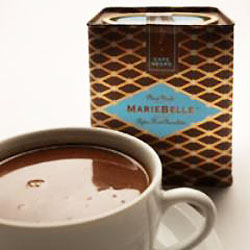 the preparation to an equal amount of boiling water resulted in a soupy, lumpy brew that looked unappetizing. Even heating the mixture in a microwave for the suggested ten seconds (repeatedly) and stirring afterwards didn’t help. On the other hand, if you place the mix in a small bowl and gradually whisk in an equal amount of boiling water, you come up with a velvety-smooth, slightly thick hot chocolate that is a positive delight. Consumers pay serious money for this (and many other) hot chocolate preparations. Shouldn’t the directions as well as the product give them their money’s worth? (EDITOR’S NOTE: We’ve had the same experience: our Marie Belle mixes never taste as divine as they do when we stop at Marie Belle’s chocolate shop in the SoHo neighborhood of New York City and order a cup (as of this update, there’s a shop uptown on Madison Avenue, too). We’re sure she uses half and half at the shop—or at least sweet butter, an old trick to make hot chocolate even richer. Even if you need to go out of your way to have a cup, it’s worth the trip.
the preparation to an equal amount of boiling water resulted in a soupy, lumpy brew that looked unappetizing. Even heating the mixture in a microwave for the suggested ten seconds (repeatedly) and stirring afterwards didn’t help. On the other hand, if you place the mix in a small bowl and gradually whisk in an equal amount of boiling water, you come up with a velvety-smooth, slightly thick hot chocolate that is a positive delight. Consumers pay serious money for this (and many other) hot chocolate preparations. Shouldn’t the directions as well as the product give them their money’s worth? (EDITOR’S NOTE: We’ve had the same experience: our Marie Belle mixes never taste as divine as they do when we stop at Marie Belle’s chocolate shop in the SoHo neighborhood of New York City and order a cup (as of this update, there’s a shop uptown on Madison Avenue, too). We’re sure she uses half and half at the shop—or at least sweet butter, an old trick to make hot chocolate even richer. Even if you need to go out of your way to have a cup, it’s worth the trip.
Some manufacturers go the reverse route, not listing enough information. Especially if one is a novice in the kitchen, it’s not helpful when directions are insufficient. Some, such as Hot Chocolate Sparrow’s preparation, call for adding 2 tablespoons of the mix to “hot milk,” no quantity given. I’ve been playing in kitchens for far too many years, so I can assign what will probably be a reasonable quantity of liquid to a given amount of mix (generally 6 ounces is a good bet). But others, like Café-Tasse Chocolat en Poudre, have no instructions whatsoever. Perhaps the Belgians know from birth what the proper proportions are. But making a cup of comfort on a cold winter evening shouldn’t have to be an intellectual exercise. Give consumers a range of liquid or mix amounts to provide for individual taste preferences, but don’t make them guess.
Make Sure It Tastes Like Chocolate—Or Find Something That Does
This shouldn’t even be necessary to state, but 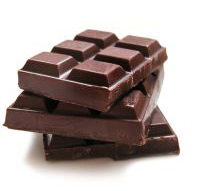 sadly, it is. Hot cocoa and hot chocolate preparations should, quite simply, have a decent chocolate flavor; they shouldn’t be entirely sweet, with no chocolate taste. Many of the supermarket brands tasted predominantly of sweetener, with little to no chocolate flavor. However, some of the more expensive brands had a similar problem. Although they were less sweet, chocolate flavor was also lacking. If something is called “hot chocolate” or “hot cocoa,” shouldn’t chocolate flavor be a priority? It needn’t be ultra-bittersweet, but the taste of chocolate should be noticeable.
sadly, it is. Hot cocoa and hot chocolate preparations should, quite simply, have a decent chocolate flavor; they shouldn’t be entirely sweet, with no chocolate taste. Many of the supermarket brands tasted predominantly of sweetener, with little to no chocolate flavor. However, some of the more expensive brands had a similar problem. Although they were less sweet, chocolate flavor was also lacking. If something is called “hot chocolate” or “hot cocoa,” shouldn’t chocolate flavor be a priority? It needn’t be ultra-bittersweet, but the taste of chocolate should be noticeable.
Go To Page 6: Make Hot Chocolate From Scratch: Recipes
Go To The Article Index Above
Lifestyle Direct, Inc. All rights reserved. Photos are the copyright of their respective owners.


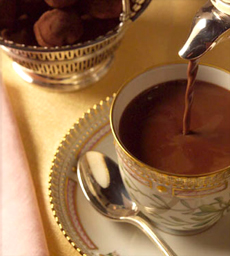
 R&D intern at Guittard Chocolate, I learned that chocolate and salt have a special relationship. In the complete absence of salt, even a favorite chocolate dessert can sometimes taste flat and less chocolatey. The key lies in the amount of salt used: Only a minimal quantity is required to bring out that full chocolate flavor we all desire. When I make hot cocoa, hot chocolate, or anything chocolate from scratch, I always throw in just a tiny amount. For a cup of hot chocolate, that “tiny amount” will be literally a few grains. For larger desserts, such as a cake or pan of brownies, it might be as much as 1/8 to 1/4 of a teaspoon.
R&D intern at Guittard Chocolate, I learned that chocolate and salt have a special relationship. In the complete absence of salt, even a favorite chocolate dessert can sometimes taste flat and less chocolatey. The key lies in the amount of salt used: Only a minimal quantity is required to bring out that full chocolate flavor we all desire. When I make hot cocoa, hot chocolate, or anything chocolate from scratch, I always throw in just a tiny amount. For a cup of hot chocolate, that “tiny amount” will be literally a few grains. For larger desserts, such as a cake or pan of brownies, it might be as much as 1/8 to 1/4 of a teaspoon. chocolate drink. Others among us don’t mind going to a little more trouble to achieve a really delicious product, but some manufacturer’s preparation instructions bordered on the ridiculous.
chocolate drink. Others among us don’t mind going to a little more trouble to achieve a really delicious product, but some manufacturer’s preparation instructions bordered on the ridiculous.  the preparation to an equal amount of boiling water resulted in a soupy, lumpy brew that looked unappetizing. Even heating the mixture in a microwave for the suggested ten seconds (repeatedly) and stirring afterwards didn’t help. On the other hand, if you place the mix in a small bowl and gradually whisk in an equal amount of boiling water, you come up with a velvety-smooth, slightly thick hot chocolate that is a positive delight. Consumers pay serious money for this (and many other) hot chocolate preparations. Shouldn’t the directions as well as the product give them their money’s worth? (EDITOR’S NOTE: We’ve had the same experience: our Marie Belle mixes never taste as divine as they do when we stop at Marie Belle’s chocolate shop in the SoHo neighborhood of New York City and order a cup (as of this update, there’s a shop uptown on Madison Avenue, too). We’re sure she uses half and half at the shop—or at least sweet butter, an old trick to make hot chocolate even richer. Even if you need to go out of your way to have a cup, it’s worth the trip.
the preparation to an equal amount of boiling water resulted in a soupy, lumpy brew that looked unappetizing. Even heating the mixture in a microwave for the suggested ten seconds (repeatedly) and stirring afterwards didn’t help. On the other hand, if you place the mix in a small bowl and gradually whisk in an equal amount of boiling water, you come up with a velvety-smooth, slightly thick hot chocolate that is a positive delight. Consumers pay serious money for this (and many other) hot chocolate preparations. Shouldn’t the directions as well as the product give them their money’s worth? (EDITOR’S NOTE: We’ve had the same experience: our Marie Belle mixes never taste as divine as they do when we stop at Marie Belle’s chocolate shop in the SoHo neighborhood of New York City and order a cup (as of this update, there’s a shop uptown on Madison Avenue, too). We’re sure she uses half and half at the shop—or at least sweet butter, an old trick to make hot chocolate even richer. Even if you need to go out of your way to have a cup, it’s worth the trip.  sadly, it is. Hot cocoa and hot chocolate preparations should, quite simply, have a decent chocolate flavor; they shouldn’t be entirely sweet, with no chocolate taste. Many of the supermarket brands tasted predominantly of sweetener, with little to no chocolate flavor. However, some of the more expensive brands had a similar problem. Although they were less sweet, chocolate flavor was also lacking. If something is called “hot chocolate” or “hot cocoa,” shouldn’t chocolate flavor be a priority? It needn’t be ultra-bittersweet, but the taste of chocolate should be noticeable.
sadly, it is. Hot cocoa and hot chocolate preparations should, quite simply, have a decent chocolate flavor; they shouldn’t be entirely sweet, with no chocolate taste. Many of the supermarket brands tasted predominantly of sweetener, with little to no chocolate flavor. However, some of the more expensive brands had a similar problem. Although they were less sweet, chocolate flavor was also lacking. If something is called “hot chocolate” or “hot cocoa,” shouldn’t chocolate flavor be a priority? It needn’t be ultra-bittersweet, but the taste of chocolate should be noticeable.